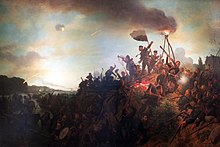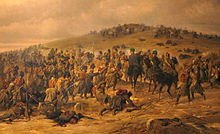War of the Duchies
The War of the Duchies or Second War of Schleswig was a military conflict between the Austrian Empire and Prussia against Denmark in 1864. The latter country was defeated, for what Schleswig-Holstein had to cede, which was annexed by the other two powers. The war ended on October 30, 1864, when the Treaty of Vienna formalized Denmark's cession of the duchies of Schleswig, Holstein, and Saxony-Lauenburg to Prussia. and Austria.
Background
The precedents for the War of the Duchies can be found in 1863, when the German Confederation protested against the attempt of the Danish monarch, Christian IX, to incorporate the duchy of Schleswig, which was under official German control, into Denmark. The London Protocol of 1852 had provided for Schleswig to be united with the Duchy of Holstein, which was a member of the German Confederation. The Prussian Chancellor, Otto von Bismarck, convinced Franz Joseph I of the House of Austria to jointly defend the London Protocol. On January 16, 1864, the agreement was signed between them. Bismarck issued an ultimatum to Denmark in which he demanded that the November Constitution must be abolished within 48 hours, which was rejected by the Danish government.
Austrian and Prussian forces crossed the Eider River, the border between Schleswig (to the north) and Holstein (to the south), on February 1, 1864, and war was inevitable.
Development
Austrian and Prussian forces invaded the Jutland peninsula, beginning the War of the Duchies. In December 1863 Confederate troops entered Holstein, which was occupied with almost no resistance. The Danish government abandoned Holstein and sent the Danish army to the Schleswig-Holstein border. Most of the units fortified behind the Danevirke. It was not until February of the following year when Marshal Helmuth von Moltke was able to demonstrate the effectiveness of his approach in the conquest of the Duchy of Schleswig, which took place in four days. Moltke's plans had gone unheeded by the operational commanders, and only by being granted supreme command was he able to mount a lightning campaign of immediate effectiveness. In August 1864, Denmark was defeated by Moltke's army and was forced to hand over the disputed territories to Austria and Prussia.
According to the provisions of the Gastein convention that put an end to it, the duchy of Holstein came under Austrian rule, and those of Schleswig and Lauenburg under Prussia, but neither country was satisfied with the agreement.
In the sea
As in the first Schleswig war, the task of the Danish Navy was to prevent landings on the islands and blockade the German Baltic Sea fleet—and North Sea ports. The Prussian fleet was still in its infancy. Danish ships could move unimpeded off German coastal cities and seize German merchant ships. A Prussian attempt to dislodge the fleet from the waters around Rügen was repulsed (the Battle of Rügen). The Trieste-based Austrian fleet sent two frigates into the North Sea to lift the blockade of Hamburg. The Danish squadron achieved a tactical victory over the Austrians, who were reinforced with three Prussian gunboats, on May 9, 1864 on the island of Heligoland. These naval battles, however, did not affect the outcome of the war.
Consequences
In the first clash of arms since the reorganization of the Prussian forces, their effectiveness was clear. Something that the Austrians ignored and cost them defeat in the Austro-Prussian War 18 months later and that contributed to a perception in the German states that Prussia was the only state that could defend the other German states against external aggression. Prussia and Austria took over the respective administration of Schleswig and Holstein under the Gastein Convention of August 14, 1865. About 200,000 Danes fell under German rule.
After the loss, Christian IX went behind the back of the Danish government to contact the Prussians, offering that the whole of Denmark could join the German Confederation, if Denmark remained united with Schleswig and Holstein. This proposal was rejected by Bismarck, who feared that the ethnic strife in Schleswig between Danes and Germans would then go unresolved.
The Peace of Prague in 1866 confirmed Denmark's cession of the two duchies, but promised a plebiscite to decide whether Northern Schleswig wished to return to Danish rule. This provision was established unilaterally by a resolution of Prussia and Austria in 1878.
The defeat left deep marks on Danish national identity. After her, Denmark adopted a policy of neutrality that it maintained during the First World War.
Chancellor Bismarck deliberately hampered the Austrian administration of Holstein and sent troops to Holstein when Austria protested to the Frankfurt Parliament. The situation triggered the Seven Weeks War between the two Germanic powers.
Currently, the disputed territory in the War of the Duchies is the German federal state of Schleswig-Holstein.
Contenido relacionado
Demosthenes
Protectorate
Celtic languages


